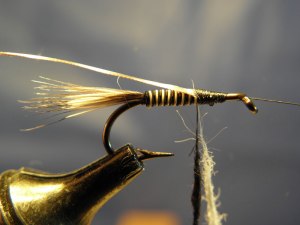
I enjoyed a lot of success as a kid one summer with a traditionally tied mosquito dry fly, but then one day it stopped working, just like that. Ah, such is trout fishing! Further observation revealed that the fish had switched to sub-surface feeding, so I was forced into fishing nymphs. I caught a few fish with a hare’s ear, but thought that I could have achieved more success with a nymph that featured the same color scheme as the mosquito dry, since the trout were already keyed into that. Therefore, I designed a nymph that was comprised of white and black, like the dry. I used to call it the Grizzly Nymph, which delineates the color scheme of the popular barred rock feathers, as well as the colors of the traditional dry mosquito dressing. More recently I refer to it as the Magpie Nymph, since these birds offer good wing case material. The design is actually the same as any other nymph pattern, aside from color. Consequently, I think the eye-catching color contrast is what makes the pattern successful. Since a standard nymph pattern does not look much like a mosquito larvae, I did not want to call it a mosquito nymph. I’ve been fishing with this fly since the 80’s. Subsequently, the pattern is so simple and effective that I’ve often wondered why it had not been popularized much earlier.









Dressing guidelines:
Hook: your favorite nymph hook
Bead: (optional) white, black, or silver bead.
Thread: Black with white bead, or vice versa; 6/0 or 8/0.
Abdomen: white and black ultra wire, wrapped together; or one strand each of black and white dubbing.
Ribbing (optional): silver wire or tinsel
Thorax: white and black dubbing mixture; maintain either mostly white or mostly black in the mixture, or, like the abdomen, twist a white and a black dubbing strand separately, then wrap them together. If black & white are blended 50% each, the outcome tends to be more gray in appearance than grizzly.
Wing case: white & black barred feather section; or latex or other synthetic material speckled with a permanent marker.
Hackle/legs: (optional) grizzly hen, or another black & white barred feather such as guinea, starling or partridge.
Author’s note: I have also found it useful to focus individual patterns with either the white or the black. For example, a predominantly black pattern should be highlighted by white streaks, or vice versa. Along these lines, a mostly black wing case should be contrasted against a white thread head.





